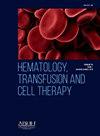B-LINEAGE PROGENITORS AND CD38-POSİTİVE B CELLS ARE ASSOCIATED WITH SURVIVAL RATES IN BREAST CANCER PATIENTS
IF 1.8
Q3 HEMATOLOGY
引用次数: 0
Abstract
Objective
The immune system plays an increasingly important role in the development of targeted strategies for breast cancer. According to mRNA sequencing data from The Cancer Genome Atlas (TCGA) high expression B cell signatures has beneficial effects on survival rates in many tumors. Bone marrow (BM) is poorly understood from the point of view of the prognostic role of hematopoietic cells and subpopulations of lymphocytes in patients with breast cancer (BC).
Methodology
. Study was carried out in 107 BC patients. The immunological and morphological methods were applied. Multiparameter flow cytometry with antibodies to B-cell populations was used (CD19, CD20, CD5, CD38, CD10, CD45, HLA-DR, CD27), FACSCANTO II. Studies of BM lymphocyte subpopulations were carried out in the gate of CD45++ cells. The duration of the follow-up period after surgery was 8 years.
Results
The total percentage of B cells in BM was significantly associated with the prognosis of BC. B-1 cells were associated with progression-free and disease-free survival. Disease progression was observed at low levels of B1 cells. In cases more than 10% B-lymphocytes in the BM of BC patients overall survival (OS) rates were more favorable (p = 0.01). Especially for BC with a high Ki-67. Disease progression was observed in 1/3 of BC patients with low levels of B1 cells. CD38 expression on B cells was a prognostically favorable factor: the role is realized during 5–10 years of follow-up after surgery. Level CD38+ B cells more then 10% correlated with high OS, p = 0.02. The presence of CD10+CD19+ B-lineage precursors was associated with a more favorable prognosis (OS, the threshold level 12%, р = 0,04). The prognostic role of the CD10 antigen was realized when patients were observed for more than 5 years.
Conclusion
. Total relative number of (more than 10 %) of BM CD19+ cells were significantly related to OS in BC. B-cell precursors and CD38+ B cells were associated with favorable prognosis. Prognositic role of B-lineage precursors and CD38-positive cells was in the periods of 5–10 years after surgery.
求助全文
约1分钟内获得全文
求助全文
来源期刊

Hematology, Transfusion and Cell Therapy
Multiple-
CiteScore
2.40
自引率
4.80%
发文量
1419
审稿时长
30 weeks
 求助内容:
求助内容: 应助结果提醒方式:
应助结果提醒方式:


